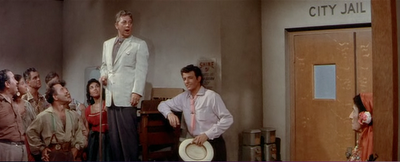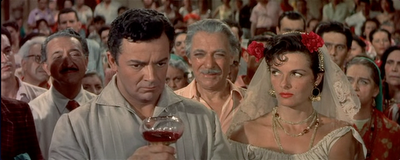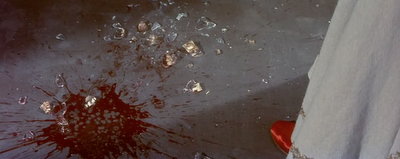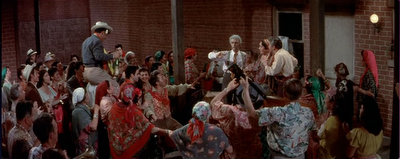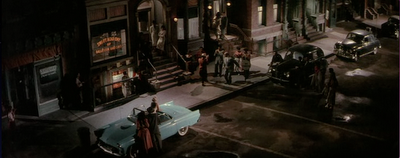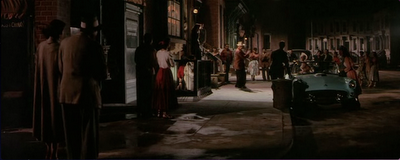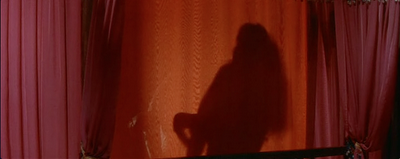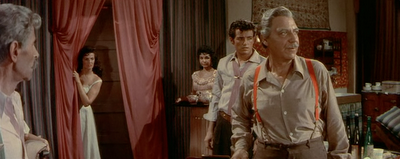Nicholas Ray specialized in making films about misfits and outsiders coalescing into the nuclear units of new collectives, more often than not marking such formations with the harsh tragedies of emerging orders. But as Evan Davis rightly noted, Hot Blood is "the first film in which Ray begins from within a fully formed community." This would become a staple of Ray's late career, leading to journeys to Peking, the wild swamps of Florida and the Arctic. What links these movies is an ignorance of their subjects' cultures that cannot be entirely forgiven even with historical perspective in mind. However, like the misguided but not altogether untruthful depiction of Inuits in The Savage Innocents, the gypsies of Hot Blood serve a broader purpose that pushes their cultural traits, both accurate and inaccurate, into universal terms of societal abstraction. The fundamental point is that their system of values is not that of the traditional West's, and by focusing tightly on their isolated world of customs, Ray can not only show that the American way of life is not the only one but that it can even look as ridiculous to others as those people's civilizations look to us.
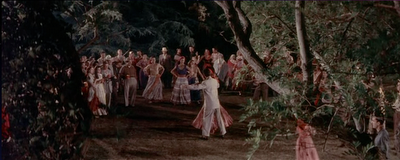
It should be noted up front, however, that Hot Blood does not approach the level of thematic depth of The Savage Innocents. In fact, it boasts the weakest screenplay of any Ray film since A Woman's Secret. Like that film, Hot Blood squanders a potential mindfield of twists and turns, but where Ray and Mankiewicz clearly put a great deal of stock into their lifeless melo-noir, the director here cares little for the narrative. Instead, Ray devotes his attention to various dance numbers, color-soaked expressions of lust and violence that constantly push the film to the verge of becoming a musical. But it never crosses that line, perhaps because we'd forgive it its excesses if it did so. But Ray seems to delight in the garishness of it all—and of making a quasi-musical without identifiable songs and relying on dances from amateur dancers—and this is the only film so brazen that "gaudy" becomes a compliment.
The patriarch of the gypsy society shown within is Marco, a middle-aged man who goes by the sobriquet "The King of the Gypsies." Secretly ailing from a disease, Marco wishes to transfer his title to his younger brother Stephano (Cornell Wilde), but first he needs his impetuous kid brother to get married. Following custom, he arranges a marriage between Stephano and a gorgeous gypsy woman amusingly named Annie (Jane Russell, no stranger to films that needed her to dance despite formal training) without his brother's knowledge. Stephano, shown to be more attached to the normal Americans around him than his own people, recognizes Russell's beauty but insists on choosing his own wife. This position, obviously not an unreasonable, nevertheless sends the situation into a tizzy, and soon Stephano and Annie are locked into a psychological battle to hurt the other.
That these various threads never generate tension speaks to the weakness of the screenplay, but Ray uses every setup to lead to another musical interlude. The friction between Wilde and Russell gives each of these dances a restlessness not of desire but of clashing mindsets and resentment. Frustration pours out of Wilde when he slips away at night to hang with his regular friends and vent about the prejudice he encounters from the outside world (a dance instructor won't give him a job despite his prodigious skill) and the hindering traditions that shackle him to an outmoded way of life. Annie, on the other hand, feels humiliated by his attempts to push her into divorcing him, so she commits to seducing him entirely, then belatedly fulfilling his demand. Their mutual dances crackle with sparks of mutual loathing flowing in and out of genuine attraction, and their wedding dance, which involves the suggestive use of a whip, exemplifies the swirl of carnal desire, pure hatred and thin distinctions between lust and violence that defines the film.
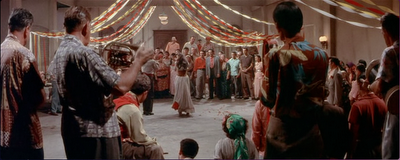
Even the climactic airing of grievances between Marco and Stephano unfolds as a sort of dance, the endpoint of the violent urges underneath the dance moves of the whole film. Ray brilliantly stages in the trailer park where Marco hides the retirement trailer he intends to use to travel, ironically making him more like a traditional, nomadic gypsy through modern Western technology. But the brothers fight with belts according to tradition, further connecting their lithe exchange of blows to conflicts of tradition vs. change. As such, stylistic diversions that these dances might be, they nevertheless exhibit the torrent of conflicting emotions working in disharmony. In that sense, the film presages The Savage Innocents not merely in its racial outsiderdom but in its anti-Manichean collision of yin and yang into an amorphous, contradictory whole that defines the self-deating paradoxes of humanity. It even frames an outdoor scene of the gypsies dancing through the natural frame of trees as if to obscure and hide the society from the rest of the world around it, a lost world bustling behind dwindling patches of untamed forests. Such touches add resonance and artistry to what would otherwise be a pointless melodrama that can't even draw narrative tension out of the possibilities of terminal illness, in-fighting clans or encroaching modernity.
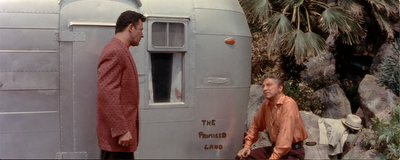

Though I'd side with Johnny Guitar and Party Girl as the better displays of wholly uninhibited color, Hot Blood's paean to red makes it so tacky it loops back around into beauty. Practically everyone in this movie wears red, subtly suggesting a collective of Jim Starks, a color-matched look at what Jim's world would look like after he built up a community of like-minded people. The happy ending that closes Hot Blood may be as forced and half-baked as the rest of the script, but after basking in the abstract ecstasy of a master's form for 80 minutes, that all seems a secondary concern.
